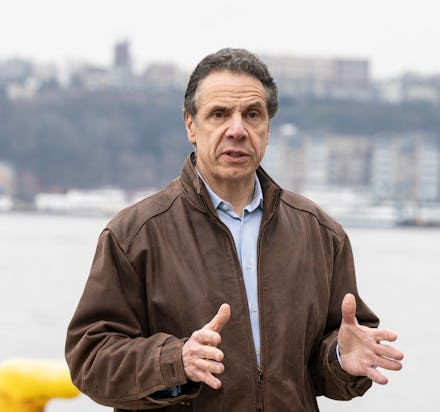Gov. Andrew Cuomo rips White House on making states compete for ventilators

As the White House continues its uneven coronavirus response, states are fighting to take matters into their own hands. On Tuesday, New York Gov. Andrew Cuomo (D) sounded the alarm at a press conference about the lack of coordination from the federal government on ventilator purchases at the state level. While it may sound like the kind of baroque bureaucratic boondoggle that most people tend to ignore, the issue could very likely have enormous life and death outcomes in the real world.
Currently, states are facing massive shortcomings in the amount of available life-saving ventilators needed to treat patients as they fight coronavirus, which primarily affects the lungs. As the disease’s spread has ballooned, states have begun placing orders for tens of thousands of new ventilators to keep patients alive. The problem, Cuomo explained, is that states are competing directly with each other to buy the critical health equipment, driving up prices in the process.
“You have 50 states competing to buy the same item,” Cuomo said. “We all wind up bidding up each other and competing against each other where you now literally will have a company call you up and say, ‘Well, California just outbid you.’”
“It’s like being on eBay with 50 other states, bidding on a ventilator,” Cuomo quipped. And as prices surge and the huge demand puts increasing pressure on the supply chain, slowing down production, states are driven to purchase as many ventilators as they can — at any cost.
"Did you really have to learn that 50 states shouldn’t compete against 50 states, and then FEMA shouldn’t come in late and compete with 50 states?"
To make matters worse, Cuomo added, the Federal Emergency Management Agency has joined the bidding war, without issuing any guidance to states about what they should be doing. “FEMA is bidding on top of the 50 states,” Cuomo said, “so FEMA is driving up the price. What sense does this make? FEMA should have been the purchasing agent: buy everything and then allocate by need to the states. Why would you create a situation where the 50 states are competing with each other — and then the federal government and FEMA comes in and competes with the rest of it?”
President Trump last week accused New York of asking for ventilators it doesn’t need. In a veiled response, Cuomo noted that despite the sky-high prices, he’s ordered 17,000 ventilators from China at a price of roughly $25,000 each. The price he’s willing to pay indicates how real and desperate the situation is, he says, despite Trump’s claims that he’s inflated the state’s ventilator needs.
“The last thing I want to do is buy a single ventilator I don’t need,” Cuomo said, noting that New York State is “broke.”
Cuomo said that coronavirus spread projections have put New York’s demand for ventilators somewhere between 20,000 and 40,000 machines within one to three weeks. But due to the bidding war, Cuomo said he’s not sure his state will even be able to get ahold of most of the units he ordered from China. In fact, he said Tuesday, he only has a “firm expectation” of receiving 2,500 ventilators out of the total order within the next two weeks.
Much of the blame for this lies with the White House, which could have provided firm guidelines for how FEMA could acquire and distribute the necessary equipment to afflicted states. The White House’s response has been erratic, however, and not providing FEMA with instruction is just one of many errors its made. Without using Trump’s name, Cuomo threw a jab his way. “Anyone could’ve told you a lot of these things,” he said. “Did you really have to learn that 50 states shouldn’t compete against 50 states, and then FEMA shouldn’t come in late and compete with 50 states? It’s not like you had to go to the Harvard Kennedy School [of Government] to learn this.”
Trump, of course, loves to tout his degree from the University of Pennsylvania’s Wharton School of Business.